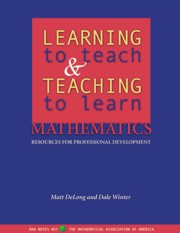Book contents
- Frontmatter
- Preface
- Contents
- 1 The Professional Development Program
- 2 How to Use this Book
- 3 An Orientation Session for the Beginning of the Semester
- 4 Making In-class Groups Work
- 5 Getting Students to Read the Textbook
- 6 Assessing and Evaluating Students' Work
- 7 Managing Homework Teams
- 8 Teaching During Office Hours
- 9 Establishing and Maintaining Control in Your Classroom
- 10 Proctoring Tests and Examinations
- 11 Teaching with Calculators and Computers
- 12 Making Lesson Plans
- 13 Strategies for Motivating Students
- 14 Dealing With Difficult Instructor-Student Situations
- 15 End-of-Semester Administration
- 16 Adapting Materials and Designing Your Own Meetings
- 17 Classroom Visits
- A Tips for Running Meetings
- B The Michigan Introductory Program
- Bibliography
A - Tips for Running Meetings
- Frontmatter
- Preface
- Contents
- 1 The Professional Development Program
- 2 How to Use this Book
- 3 An Orientation Session for the Beginning of the Semester
- 4 Making In-class Groups Work
- 5 Getting Students to Read the Textbook
- 6 Assessing and Evaluating Students' Work
- 7 Managing Homework Teams
- 8 Teaching During Office Hours
- 9 Establishing and Maintaining Control in Your Classroom
- 10 Proctoring Tests and Examinations
- 11 Teaching with Calculators and Computers
- 12 Making Lesson Plans
- 13 Strategies for Motivating Students
- 14 Dealing With Difficult Instructor-Student Situations
- 15 End-of-Semester Administration
- 16 Adapting Materials and Designing Your Own Meetings
- 17 Classroom Visits
- A Tips for Running Meetings
- B The Michigan Introductory Program
- Bibliography
Summary
The chapters in this book provide detailed information for orchestrating training meetings. Trainers are frequently faced with situations that the meeting descriptions do not anticipate. This appendix is included as a resource for dealing with the inevitable surprises and problems that arise when running effective training meetings. This is a helpful section to read before running any training meetings at all. It is also intended to serve as a reference for dealing with recurrent problems. This appendix is intended to be helpful, but not encyclopedic.
To Meet or Not To Meet
When asked how to improve meetings, many people will supply one or more of the following suggestions.
Make the meetings shorter.
Have fewer of them.
Make the meetings more relevant to me.
Get rid of them altogether.
The unfortunate reality of the situation is that many people have no love for meetings, and many consider meetings to be a complete waste of time. Part of this stems from the fact that many meeting participants have difficulty organizing their time and priorities, but some also stems from the fact that meetings can be long, boring, and unnecessary. Before planning or announcing a meeting, trainers must ask themselves the important question,
“Do we really need to have a meeting at all?”
If the honest answer to this question is “No,” in other words, if there is an equally effective and reliable way to convey information to instructors or help them make sense of their experiences, then trainers should seriously consider not holding a meeting at all.
- Type
- Chapter
- Information
- Learning to Teach and Teaching to Learn MathematicsResources for Professional Development, pp. 237 - 254Publisher: Mathematical Association of AmericaPrint publication year: 2002

